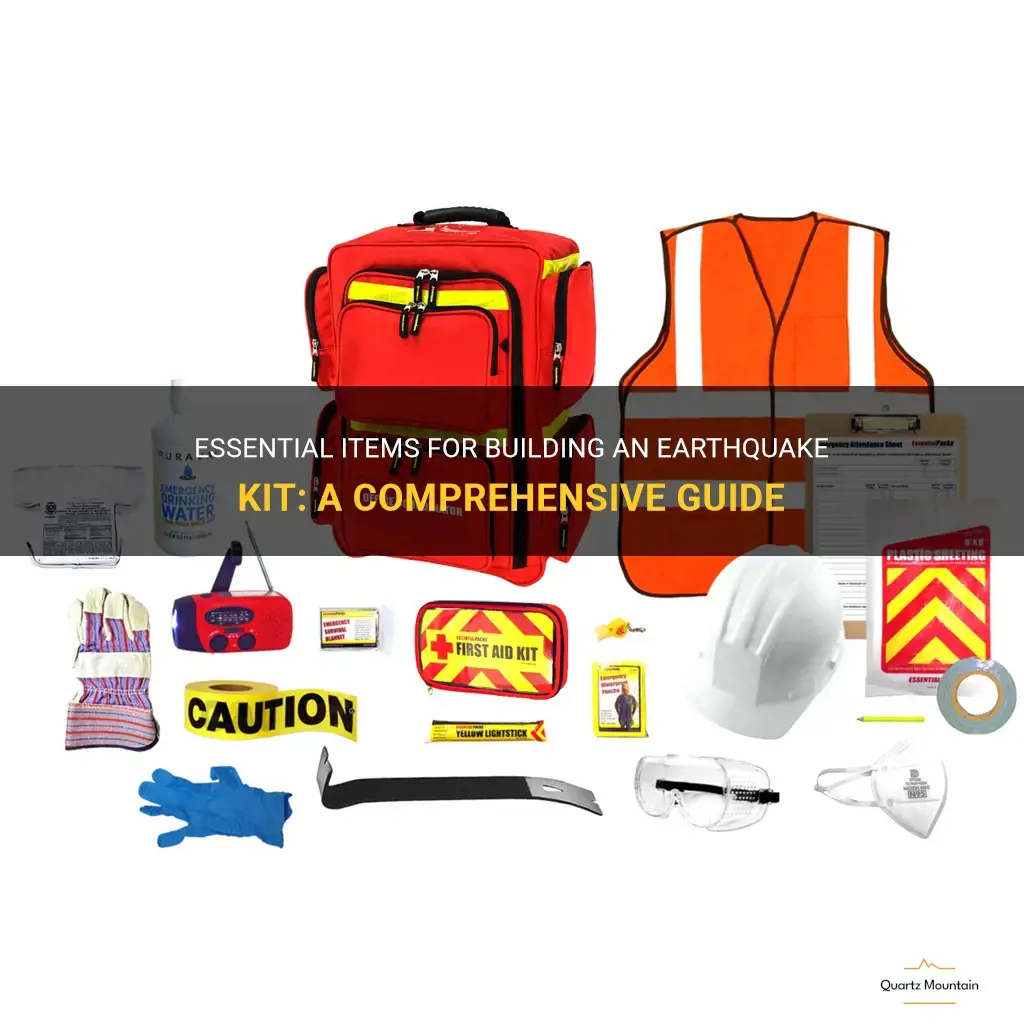
Imagine a scenario where your serene morning turns into a chaotic nightmare as the ground begins to rumble violently beneath your feet. It's an earthquake, and as you scramble to find safety, you realize you are woefully unprepared. Don't let this hypothetical situation become a terrifying reality - instead, take control of your safety by building an earthquake kit. In this comprehensive guide, we will walk you through the essential items you need to include in your kit to ensure you have everything you need to weather the tremors and aftermath of an earthquake. So, let's dive in and start building your quake-ready survival pack today!
| Characteristics | Values |
|---|---|
| Food | Non-perishable, easy-to-eat food |
| Water | One gallon per person per day |
| First aid kit | Bandages, medications, etc. |
| Communications | Battery-powered radio |
| Flashlight | With extra batteries |
| Whistle | To signal for help |
| Blankets | Warmth and comfort |
| Multi-tool | Swiss Army knife or similar |
| Cash | Small bills and coins |
| Important documents | Copies of IDs, insurance, etc. |
| Personal hygiene | Soap, toothbrush, etc. |
| Shelter | Tent or tarp |
What You'll Learn
- What are the essential items to include in an earthquake kit?
- How much food and water should be packed in an earthquake kit?
- Is it necessary to include emergency supplies such as flashlights and batteries in an earthquake kit?
- Are there any specific items that should be included in an earthquake kit for individuals with special medical needs?
- What type of clothing and personal hygiene items should be packed in an earthquake kit?

What are the essential items to include in an earthquake kit?
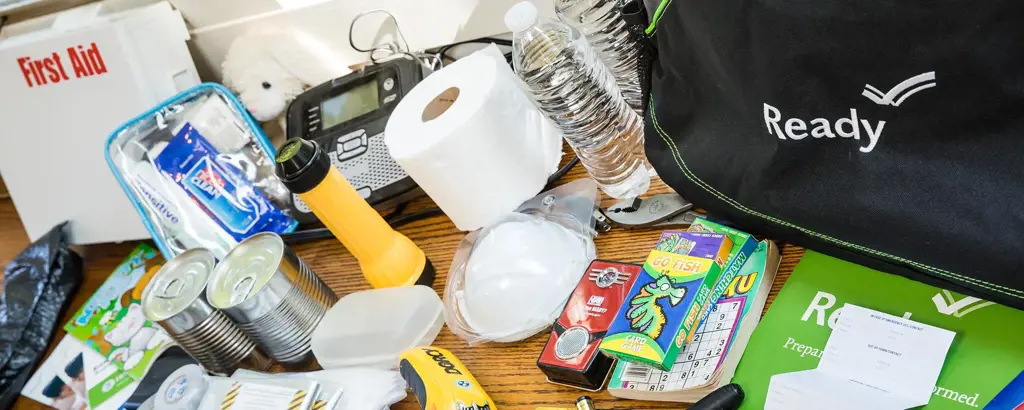
Having an earthquake kit prepared and easily accessible is crucial for everyone living in an area prone to seismic activity. When an earthquake strikes, it can cause severe damage to infrastructure, leaving people without access to basic necessities such as water, food, and shelter. To ensure the safety and well-being of yourself and your loved ones during an earthquake, it is important to have a well-stocked earthquake kit that contains the essential items.
Water is the most critical resource in any emergency situation, including an earthquake. It is recommended to have at least one gallon of water per person per day for a minimum of three days. Store the water in sturdy, leak-proof containers and replace it every six months. Along with water, it is also advisable to have water purification tablets or a filtration system in case clean water becomes scarce.
Food should be non-perishable, easy to prepare, and provide a sufficient amount of calories and nutrients. Canned goods, dry mixes, and energy bars are excellent options for earthquake kits. It is important to regularly check the expiration dates and replace food items as needed. Additionally, include a manual can opener and disposable plates and utensils in your earthquake kit.
A first aid kit is indispensable in any emergency situation. It should contain essentials such as bandages, antiseptic wipes, adhesive tape, pain relievers, scissors, and tweezers. Familiarize yourself with the contents of the first aid kit and make sure it is well-stocked and up to date. Additionally, include any necessary prescription medications, extra glasses or contact lenses, and a list of emergency contact numbers.
In the event of a power outage or when seeking shelter outdoors, it is important to have a reliable source of light. Include a flashlight with extra batteries in your earthquake kit. Consider adding a headlamp or lantern for hands-free illumination. It is also advisable to include matches in a waterproof container, as they can be used for lighting candles or starting a fire if necessary.
During and after an earthquake, communication can become challenging. Include a battery-operated or hand-crank radio to stay informed about news, emergency alerts, and instructions from authorities. Keep spare batteries or a hand-crank charger for the radio in your earthquake kit. It is also recommended to have a whistle or a loud signaling device to attract attention if you are trapped or in need of help.
Other essential items to include in an earthquake kit are a sturdy pair of gloves, a multipurpose tool or a Swiss Army knife, plastic sheeting and duct tape for emergency repairs, a set of warm clothing and blankets, and a supply of cash in small denominations.
In conclusion, an earthquake kit should contain essential items such as water, food, a first aid kit, a source of light, a communication device, and various tools and supplies. It is important to regularly check and update your earthquake kit to ensure that all items are in good condition and within their expiration dates. By being well-prepared, you can increase your chances of staying safe and comfortable during and after an earthquake.
Essential Items to Pack for an Unforgettable African Safari
You may want to see also

How much food and water should be packed in an earthquake kit?
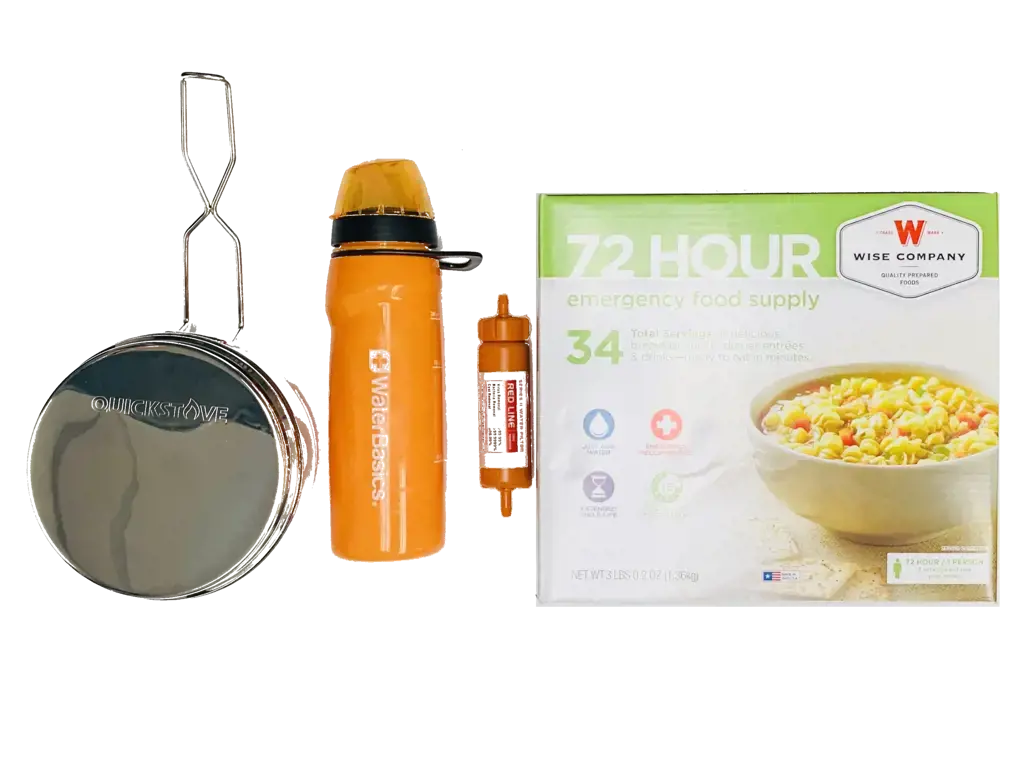
When preparing for an earthquake, one of the most important things to consider is food and water. In the event of a natural disaster, access to clean water and nourishing food may be limited, making it essential to have an earthquake kit stocked with enough supplies to sustain you and your family for an extended period of time. But how much food and water should be packed in an earthquake kit? Let's explore this topic further.
Water is the most crucial element to have in your earthquake kit as it is essential for survival. The recommended amount of water to store per person is one gallon per day. This should be enough to provide for drinking, cooking, and basic hygiene needs. It is important to keep in mind that this is a general guideline, and individual needs may vary based on factors such as age, health condition, and climate. If you live in a hot and dry area, you may need to store more water to account for increased perspiration and hydration requirements.
In terms of food, it is advisable to pack non-perishable items that can provide a balance of nutrients. Aim for foods that are easy to prepare and require little to no cooking. Canned goods such as vegetables, fruits, and proteins like beans or tuna are good options as they have a long shelf life and can be consumed straight from the can. Other suitable choices include energy bars, dried fruits, nuts, and peanut butter. Don't forget to pack a manual can opener as well.
It is recommended to have at least a three-day supply of food and water in your earthquake kit. This is based on the assumption that it may take emergency responders up to 72 hours to reach you during a large-scale disaster. However, it is wise to have an extended supply of food and water if possible, such as a one-week or even a two-week supply. This ensures you are prepared for any unforeseen circumstances or delays in receiving assistance.
In addition to food and water, there are other items you should consider packing in your earthquake kit to ensure your overall well-being. This can include medications, first aid supplies, a flashlight, extra batteries, a portable radio, and a multipurpose tool. It is also wise to have a supply of cash, as electronic payment systems may be unavailable during a disaster.
Remember that earthquake kits should be stored in a cool, dry place and regularly checked and replenished to ensure the contents are still usable. It is recommended to review and update your earthquake kit annually or as circumstances change, such as the addition of new family members.
To illustrate the importance of properly stocking an earthquake kit, let's look at a real-life example. In 2011, Japan experienced a catastrophic earthquake and tsunami that resulted in widespread damage and a high number of casualties. Many survivors were stranded without access to food and clean water for several days. Those who had prepared adequately with earthquake kits had a much higher chance of survival and were able to sustain themselves until rescue teams arrived.
In conclusion, when preparing an earthquake kit, it is crucial to pack enough food and water to sustain you and your family for an extended period. Aim for one gallon of water per person per day, and stock non-perishable food items that require little to no cooking. Having at least a three-day supply is recommended, but having a longer supply is even wiser. Regularly check and update your earthquake kit to ensure its contents are still usable. By being prepared, you increase your chances of survival and minimize the impact of a disaster on your well-being.
The Essential Food and Snack Options for a Successful Soccer Tournament
You may want to see also

Is it necessary to include emergency supplies such as flashlights and batteries in an earthquake kit?
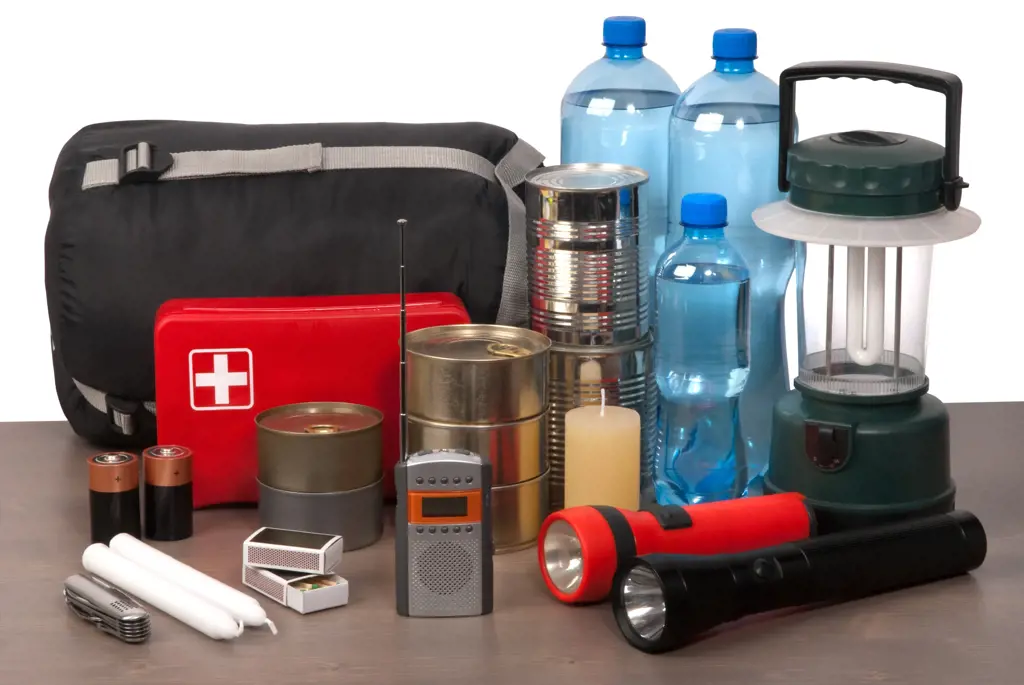
In any emergency situation, being prepared is crucial. Earthquakes are no exception. In the event of an earthquake, power outages are common, making it difficult to navigate and assess the situation. That's why including emergency supplies such as flashlights and batteries in an earthquake kit is absolutely necessary. In this article, we will explore the scientific reasons behind this, share personal experiences, provide a step-by-step guide on assembling an earthquake kit, and offer examples to further emphasize the importance of these supplies.
Scientifically speaking, earthquakes often disrupt power lines, resulting in blackouts that can last for hours or even days. During these periods, it becomes essential to have a reliable source of light. Flashlights, with their mobility and long battery life, are a practical choice in such situations. By including flashlights and an ample supply of batteries in your earthquake kit, you can ensure that you have a reliable source of light that can help you navigate safely through the dark during and after an earthquake.
Experiences from past earthquakes also underline the importance of including flashlights and batteries in an earthquake kit. Many survivors have shared their stories of being trapped in rooms or buildings following an earthquake, with no access to natural light. In these situations, having a flashlight at hand can make a significant difference. It can help individuals find their way through debris, locate necessary supplies, and increase their chances of being rescued.
To assemble an earthquake kit that includes flashlights and batteries, follow these steps:
- Select a sturdy and waterproof flashlight: Look for a flashlight that is durable and can withstand the impact of an earthquake. Waterproofing is crucial, as earthquakes can cause water leaks and floods.
- Choose LED flashlights: LED flashlights are energy-efficient and have a longer battery life compared to traditional incandescent ones. This ensures that your flashlight will last during the duration of the power outage.
- Have spare batteries: It is essential to include extra sets of batteries for your flashlight in your earthquake kit. Ensure these batteries are stored separately to prevent accidental drain.
- Include other emergency supplies: Your earthquake kit should also contain other essential items such as a first aid kit, a portable radio, non-perishable food, water, blankets, and essential medications. These supplies will help you endure the aftermath of an earthquake comfortably.
To further emphasize the importance of flashlights and batteries in an earthquake kit, consider the following examples:
- Imagine a scenario where an earthquake strikes during the night, causing widespread power outages. Without flashlights, individuals would be left in complete darkness, making it difficult to assess the damage, find essential supplies, or even seek help.
- During the Loma Prieta earthquake in 1989, the collapse of the Cypress Street Viaduct in Oakland, California, left individuals trapped in crushed cars underneath the debris. Rescuers had to navigate through the darkness without electricity, relying on flashlights to locate and save survivors.
In conclusion, including emergency supplies such as flashlights and batteries in an earthquake kit is not merely a recommendation; it is essential. Scientifically, they provide a reliable source of light in the event of power outages caused by earthquakes. Personal experiences show that they can make a significant difference in ensuring the safety and well-being of individuals following an earthquake. Following a step-by-step guide to assembling an earthquake kit that includes flashlights and batteries will help you be better prepared for any future seismic events.
Essential Items to Pack for Your Trip to Nicaragua
You may want to see also

Are there any specific items that should be included in an earthquake kit for individuals with special medical needs?
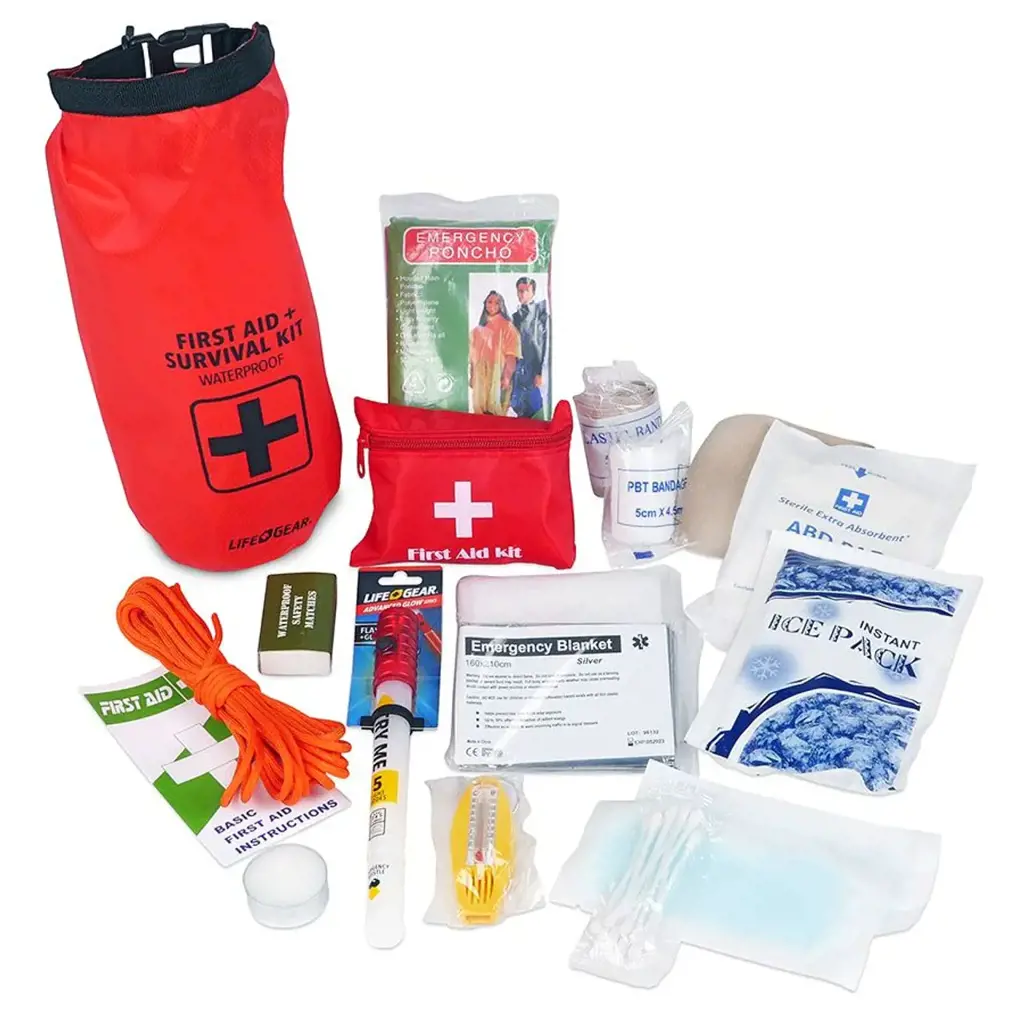
An earthquake kit is an essential item to have in any household, but it becomes even more important for individuals with special medical needs. In the event of an earthquake, access to medical supplies and equipment may be limited, making it crucial for these individuals to have a well-stocked and comprehensive earthquake kit. Here are some specific items that should be included in an earthquake kit for individuals with special medical needs.
- Medications: It is important to include a supply of necessary medications in the earthquake kit. This includes both prescription and over-the-counter medications. It is recommended to have at least a week's supply of medication on hand. It is also important to regularly check and replace medications as they expire.
- Medical equipment: Depending on the individual's specific medical needs, the earthquake kit should include any necessary medical equipment. This may include items such as oxygen tanks, nebulizers, insulin pumps, or mobility aids like wheelchairs or walkers. It is important to ensure that these items are in good working condition and that there are ample supplies, such as batteries or chargers, to keep them functioning.
- Personal care items: Individuals with special medical needs may require specific personal care items. This can include items such as catheters, wound care supplies, ostomy supplies, or adult diapers. It is important to have an ample supply of these items, as access to medical supplies may be limited in the aftermath of an earthquake.
- First aid supplies: In addition to specific medical supplies, it is important to include general first aid supplies in the earthquake kit. This includes items such as bandages, antiseptic wipes, gloves, and basic first aid instructions. These supplies can be used to tend to minor injuries that may occur during an earthquake.
- Communication devices: Individuals with special medical needs may require communication devices to stay in contact with caregivers or medical professionals. This can include items such as cell phones, walkie-talkies, or two-way radios. It is important to have a backup power source, such as extra batteries or a portable charger, to ensure that communication devices remain functional.
- Important documents: It is recommended to keep important medical documents in the earthquake kit. This includes copies of medical records, insurance information, and any emergency contact information. These documents can be helpful when seeking medical assistance or when updating medical professionals about the individual's condition.
- Non-perishable food and water: It is important to include a supply of non-perishable food and water in the earthquake kit. This is important for individuals with special medical needs as their dietary requirements may differ from others. It is recommended to include items that are easy to prepare and consume without requiring much cooking or refrigeration.
- Comfort items: Lastly, it is important to consider including comfort items in the earthquake kit. This can include items such as blankets, pillows, or favorite toys or activities to provide comfort during a stressful situation.
In conclusion, an earthquake kit for individuals with special medical needs should include specific items to cater to their unique requirements. Medications, medical equipment, personal care items, first aid supplies, communication devices, important documents, non-perishable food and water, and comfort items are all essential components of such a kit. It is important to regularly check and update the earthquake kit to ensure that all supplies are in good condition and within expiration dates. Being prepared can make a significant difference in the well-being and safety of individuals with special medical needs during an earthquake.
Essential Items to Pack for a Trip to Jamaica
You may want to see also

What type of clothing and personal hygiene items should be packed in an earthquake kit?
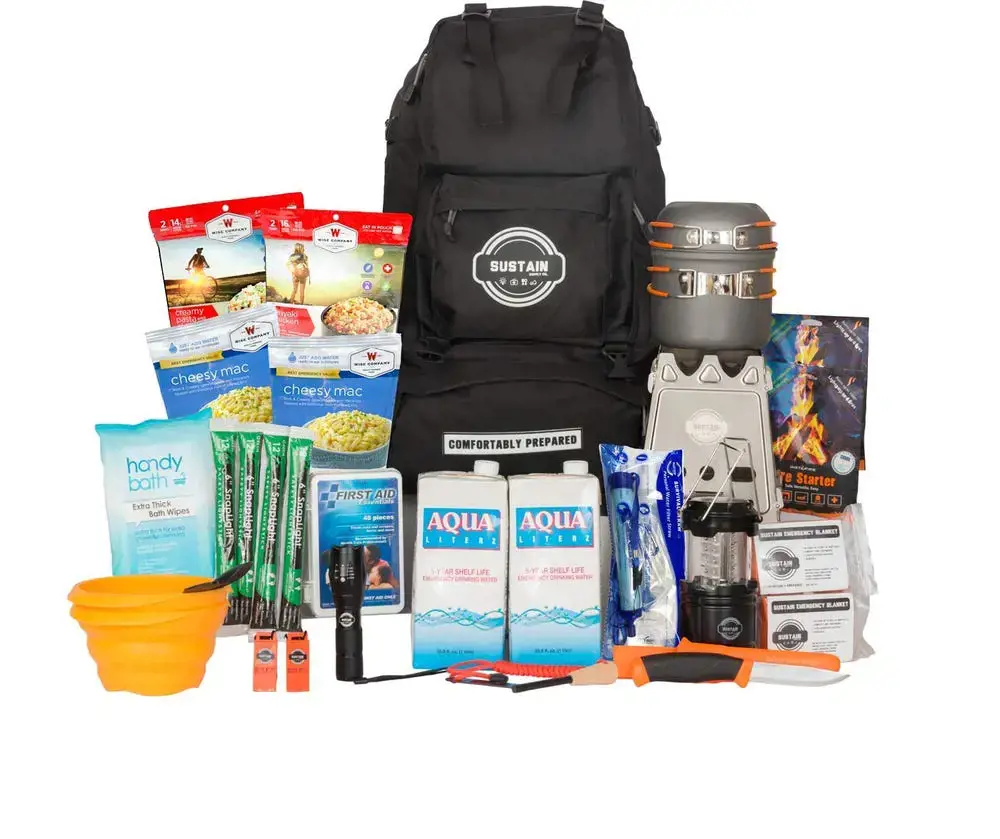
Creating an earthquake kit is an essential step in preparing for disasters. While items such as food, water, and a flashlight are typically included, it is also crucial to think about the clothing and personal hygiene items that should be packed. In the event of an earthquake, basic necessities like clean clothes and hygiene products can provide comfort and ensure overall well-being. Here are some recommendations for what to include in your earthquake kit.
Clothing:
Pack a change of clothes for each person in your household. Choose items that are comfortable and suitable for the climate in your area. It is advised to include long-sleeved shirts, pants, and sturdy shoes, as these provide protection against injuries and debris. Additionally, consider adding extra layers like sweaters or jackets for cooler temperatures. Remember to pack clothes that are seasonally appropriate and update them accordingly.
Undergarments:
Include extra sets of undergarments for each person, including bras, underwear, and socks. These items are essential for maintaining hygiene and can help prevent discomfort and infections. Pack moisture-wicking or breathable materials to reduce the risk of skin irritation and odors.
Personal Hygiene Items:
It is crucial to maintain proper hygiene during and after an earthquake. Include travel-sized toiletries such as toothbrushes, toothpaste, soap, shampoo, and deodorant. Don't forget to pack feminine hygiene products for women. Opt for products with a longer shelf life and replenish them regularly.
Towels and Washcloths:
Pack a few compact towels and washcloths that can be used for cleaning and drying purposes. These items can assist in personal hygiene routines and provide comfort in challenging situations. Consider microfiber towels, as they are lightweight, absorbent, and dry quickly.
Disposable Bags:
Include a few plastic bags in various sizes for segregating dirty or wet clothes and disposing of personal waste. These bags can help maintain cleanliness and prevent odors within your emergency kit. Opt for trash bags that are durable and waterproof.
Personal Medications:
If you or anyone in your household requires daily medication, ensure an ample supply is included in your earthquake kit. Aim to store medication in a waterproof container along with a copy of the prescription. Remember to regularly check the expiration dates and replace any expired medication.
Extra Glasses or Contact Lenses:
If you wear glasses or contact lenses, consider packing an extra pair in your earthquake kit. In emergency situations, it may be challenging to access proper eye care, and having a spare set can prevent vision impairments and discomfort.
Remember to periodically review and update your earthquake kit. Check clothing sizes of growing children, replace expired items, and adjust according to climate changes. Additionally, if you have pets, pack extra clothing and hygiene items specific to their needs.
In conclusion, including clothing and personal hygiene items in your earthquake kit is essential for comfort and maintaining overall well-being during and after an earthquake. By packing a change of clothes, undergarments, personal hygiene products, towels, and disposable bags, you can ensure that you and your family have the essentials needed to navigate challenging circumstances with a sense of normalcy and hygiene.
What to Wear: Essential Outfit Ideas for a Cruise Vacation
You may want to see also
Frequently asked questions
When packing your earthquake kit, it is important to include essential items such as non-perishable food, water, a first aid kit, flashlights, batteries, a battery-powered or hand-crank radio, a can opener, a whistle, dust masks, moist towelettes, garbage bags, a wrench or pliers to turn off utilities, a map of the local area, and any necessary medications.
It is recommended to pack at least a three-day supply of food and water per person in your household. This typically includes one gallon of water per person per day for drinking and sanitation purposes. In terms of food, choose non-perishable items that are easy to open and consume, such as canned goods, granola bars, and dried fruits.
Yes, it is important to include items for your pets in your earthquake kit. Some important items to include are extra food and water for your pets, as well as any necessary medications, a leash and collar, pet carriers or crates, litter and a litter box for cats, and any comfort items such as blankets or toys. It is also crucial to have a recent photo of your pet in case they get lost and you need to make flyers or report them missing.
It is recommended to update your earthquake kit at least once a year. Take the time to check expiration dates on food and water supplies, replace batteries in flashlights and radios, and ensure that any medications or other perishable items are replenished. Additionally, consider any changes in your household, such as new family members or pets, and adjust your earthquake kit accordingly.







